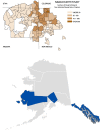Differences in cigarette and smokeless tobacco use among American Indian and Alaska Native people living in Alaska and the Southwest United States
- PMID: 20525781
- PMCID: PMC2893297
- DOI: 10.1093/ntr/ntq087
Differences in cigarette and smokeless tobacco use among American Indian and Alaska Native people living in Alaska and the Southwest United States
Abstract
Introduction: This study analyzed self-reported tobacco use among American Indian and Alaska Native (AI/AN) people enrolled in the Education and Research Towards Health Study in Alaska (n = 3,821) and the Southwest United States (n = 7,505) from 2004 to 2006.
Methods: Participants (7,060 women and 4,266 men) completed a computer-assisted self-administered questionnaire on cigarette and smokeless tobacco (ST) use.
Results: Current use of cigarettes was considerably higher in Alaska than in the Southwest United States (32% vs. 8%). Current ST use was also more common in Alaska than in the Southwest United States (18% vs. 8%). Additionally, smoking was more common among men, younger age, those who were not married, and who only spoke English at home, while ST use was more common among men, those with lower educational attainment and those who spoke an AI/AN language at home (p < .01). Compared with the U.S. general population, AI/AN people living in Alaska were more likely and those living in the Southwest United States were less likely to be current smokers. Rates of ST use, including homemade ST, in both regions were much higher than the U.S. general population.
Discussion: Tobacco use among AI/AN people in the Southwest United States, who have a tradition of ceremonial tobacco use, was far lower than among Alaska Native people, who do not have a tribal tradition. Tobacco use is a key risk factor for multiple diseases. Reduction of tobacco use is a critical prevention measure to improve the health of AI/AN people.
Figures
Similar articles
-
Surveillance for Violent Deaths - National Violent Death Reporting System, 50 States, the District of Columbia, and Puerto Rico, 2022.MMWR Surveill Summ. 2025 Jun 12;74(5):1-42. doi: 10.15585/mmwr.ss7405a1. MMWR Surveill Summ. 2025. PMID: 40493548 Free PMC article.
-
Heated tobacco products for smoking cessation and reducing smoking prevalence.Cochrane Database Syst Rev. 2022 Jan 6;1(1):CD013790. doi: 10.1002/14651858.CD013790.pub2. Cochrane Database Syst Rev. 2022. PMID: 34988969 Free PMC article.
-
Use of Flavored and Modified Risk Smokeless Tobacco Products Among American Indian Adults.Nicotine Tob Res. 2025 Aug 22;27(9):1633-1640. doi: 10.1093/ntr/ntaf047. Nicotine Tob Res. 2025. PMID: 40036228
-
Sexual Harassment and Prevention Training.2024 Mar 29. In: StatPearls [Internet]. Treasure Island (FL): StatPearls Publishing; 2025 Jan–. 2024 Mar 29. In: StatPearls [Internet]. Treasure Island (FL): StatPearls Publishing; 2025 Jan–. PMID: 36508513 Free Books & Documents.
-
Interventions for tobacco use prevention in Indigenous youth.Cochrane Database Syst Rev. 2012 Aug 15;2012(8):CD009325. doi: 10.1002/14651858.CD009325.pub2. Cochrane Database Syst Rev. 2012. Retraction in: Cochrane Database Syst Rev. 2021 Nov 30;11:CD009325. doi: 10.1002/14651858.CD009325.pub3. PMID: 22895988 Free PMC article. Retracted.
Cited by
-
Perceptions of pharmacogenetic research to guide tobacco cessation by patients, providers and leaders in a tribal healthcare setting.Pharmacogenomics. 2016 Mar;17(4):405-15. doi: 10.2217/pgs.15.177. Epub 2016 Feb 12. Pharmacogenomics. 2016. PMID: 26871371 Free PMC article.
-
Follow-up Study Methods for a Longitudinal Cohort of Alaska Native and American Indian People Living within Urban South Central Alaska: The EARTH Study.J Community Health. 2019 Oct;44(5):903-911. doi: 10.1007/s10900-019-00630-z. J Community Health. 2019. PMID: 30798425 Free PMC article.
-
Smoking Patterns Among Urban Alaska Native and American Indian Adults: The Alaska EARTH 10-Year Follow-up Study.Nicotine Tob Res. 2022 Apr 28;24(6):840-846. doi: 10.1093/ntr/ntab245. Nicotine Tob Res. 2022. PMID: 34850172 Free PMC article.
-
High tobacco use prevalence with significant regional and sex differences in smokeless tobacco use among Western Alaska Native people: the WATCH study.Int J Circumpolar Health. 2017;76(1):1398009. doi: 10.1080/22423982.2017.1398009. Int J Circumpolar Health. 2017. PMID: 29130421 Free PMC article.
-
Beta-testing the feasibility of a family-based financial incentives smoking cessation intervention with Alaska Native families: Phase 2 of the Aniqsaaq (to breathe) Study.Contemp Clin Trials Commun. 2025 Mar 17;45:101472. doi: 10.1016/j.conctc.2025.101472. eCollection 2025 Jun. Contemp Clin Trials Commun. 2025. PMID: 40224301 Free PMC article.
References
-
- Blanchette R. Fungus ashes and tobacco: The use of Phellinus igniarius by the indigenous people of North America. Mycologist. 2001;15:4–9.
-
- Blanchette R, Renner C, Held B, Enoch C, Angstman S. The current use of Phellinus igniarius by the Eskimos of Western Alaska. Mycologist. 2002;16:142–145.
-
- Carmona R, Gfroerer J, Caraballo R, Yee SL, Husten C, Pechacek T, et al. Prevalence of cigarette use among 14 racial/ethnic populations—United States, 1999–2001. Morbidity and Mortality Weekly Report. 2004;53:49–52. - PubMed
-
- Daley CM, James AS, Barnoskie RS, Segraves M, Schupbach R, Choi WS. “Tobacco has a purpose, not just a past”: Feasibility of developing a culturally appropriate smoking cessation program for a pan-tribal native population. Medical Anthropology Quarterly. 2006;20:421–440. - PubMed
-
- Edwards SL, Slattery ML, Murtaugh MA, Edwards RL, Bryner J, Pearson M, et al. Development and use of touch-screen audio computer-assisted self-interviewing in a study of American Indians. American Journal of Epidemiology. 2007;165:1336–1342. - PubMed
Publication types
MeSH terms
Grants and funding
LinkOut - more resources
Full Text Sources
Medical


